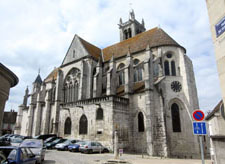Moret-sur-Loing (Seine-et-Marne, France) - La Nativité
- Disclaimer
The dating found here is based on the work of John James, and is meant on this site to serve as a starting point. James' dating is derived from a system that uses his interpretation of the development of capitals over time as the basis for chronology, among other factors. His goal is to refine the dating to within years rather than decades. I have not fully embraced James' methodology, and will be developing this page from its current state to one which is admittedly more conservative. The relative expenditure values found in the Timeline are also based on James' work, and I believe these to be reasonably reliable. They are intended only to give a sense of the amount of work involved in each decade.
I have added the idea of the "project" as a way of separating work in buildings. In my mind, a "project" is a discrete section of work in a building that resulted from the one-time acquisition of funding. "Projects" are generally separated by at least a decade where no work was being done. It is my view that it would have been unwise to start a "project" that could not be finished and protected from the elements, and as such a "project" usually involved a wing or multiple wings of a building, from floor to roof. Rural churches, which could only secure small amounts of funding at irregular intervals, often were the result of many small projects, while the great churches, which benefitted from relatively consistent funding, may have involved only a few large projects.
I have added the idea of the "project" as a way of separating work in buildings. In my mind, a "project" is a discrete section of work in a building that resulted from the one-time acquisition of funding. "Projects" are generally separated by at least a decade where no work was being done. It is my view that it would have been unwise to start a "project" that could not be finished and protected from the elements, and as such a "project" usually involved a wing or multiple wings of a building, from floor to roof. Rural churches, which could only secure small amounts of funding at irregular intervals, often were the result of many small projects, while the great churches, which benefitted from relatively consistent funding, may have involved only a few large projects.
- Timeline with Relative Expenditure (if available, in building units)
 |
 |
 |
- Project A - 1180s - Phase 1 - choir (b)
Choir footings for larger curved exterior face, on land that slopes from south to north.
- Project A - 1190s - Phase 2 - choir (s) piscine
Plan changed to straight externally, curved remained inside; visible in the bases in three campaigns for four-part high vaults; intricate piscine.
- Project A - 1190s - Phase 3 - choir (a)
Choir aisles with 6 to 10 courses per campaign with capitals.
- Project A - 1190s - Phase 4 - choir(a+)
Above arcade capitals shafts were added indicating decisions for six-part high vaults and the walls show steeper pitch in the aisles; the bases over capitals carved with start of arcade arches and 3-course tas-de-charge in aisle vaults that leaves two questions: was it then decided to raise the height of the aisles as too low, was this when it was decided to stilt the whole vault, or were all arches, tas and arcade bases, stilted in a single act?
- Project A - 1190s - Phase 5 - choir (g)
Choir gallery, interior walkway around apse, eastern oculi, from the gallery floor to the capitals in one campaign from within stairs.
- Project A - 1190s - Phase 6 - choir (g+)
Additional shafts added with sculptured supports to change high vaults back to a four-part scheme.
- Project A - 1190s - Phase 7 - choir (c)
Clerestory capitals and mullions begun with carved corbels and external walkway to high vaults in three campaigns, though not designed for flyers at this level.
- Project B - 1240s - Phase 8 - nave 1-2(a)
Slow construction in aisles of first two bays of nave.
- Primary Sources for Dating
There are no primary source documents for this building
